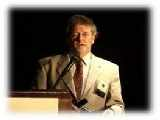Oxygen Element Discovery, Its Properties And Evolution Of Atmospheric Oxygen

Oxygen element name means "acid forming" and derives from two Greek words: oxys (acid) and genes (form). The Earth was probably formed about 4,600 million years ago by the gravitational coalescence of cold material.
Initially there was a tenuous atmosphere of hydrogen and helium which was lost because of a weak gravitational field. The secondary atmosphere was created by the thermal and radioactive decay of various Earths constituents.
Ammonia dissociated into nitrogen and hydrogen and water vapour into hydrogen and oxygen. However, by far the greatest source of oxygen was, and still is, from photosynthesis. There is some evidence to suggest that the atmospheric concentration of oxygen cannot have changed for the past 345 million years.

Oxygen element is a plentiful and highly reactive element on the earth. In Periodical Table Oxygen elemnt's properties are following:
- Atomic Number: 8
- Atomic Weight: 15.9994
- Melting Point: 54.36 K (-218.79°C or -361.82°F)
- Boiling Point: 90.20 K (-182.95°C or -297.31°F)
- Density: 0.001429 grams per cubic centimeter
- Phase at Room Temperature: Gas
- Element Classification: Non-metal
- Period Number: 2
- Group Number: 16
- Group Name: Chalcogen
Oxygen comprises about 21% of the earth's atmosphere. In its elemental form oxygen is a gas and diatomic.
| Gas | Mass % |
|---|---|
| Nitrogen (N2) | 78.084 |
| Oxygen (O2) | 20.947 |
| Argon (Ar) | 0.934 |
| Carbon Dioxide (CO2) | 0.033 |
| Neon (Ne) | 0.00182 |
| Helium (He) | 0.00052 |
| Krypton (Kr) | 0.00010 |
The earth's crust contains a large amount of oxygen as well, primarily in the form of silicates. The following list shows elemental abundances in Earth's crust:
| Element | Mass % |
|---|---|
| Oxygen | 46.6 |
| Silicon | 27.7 |
| Aluminum | 8.1 |
| Iron | 5.0 |
| Calcium | 3.6 |
| Sodium | 2.8 |
| Potassium | 2.6 |
| Magnesium | 2.1 |
| Others | 1.5 |
Many metals react with oxygen element to form oxides. For example, copper reacts with oxygen to form copper (II) oxide. Iron reacts with oxygen to form iron(III) oxide (rust). Magnesium also reacts with oxygen, forming magnesium oxide.
Metalloids will also react with oxygen. Upon reaction with oxygen silicon forms silicon dioxide, the main component of sand.
Just as with metals and metalloids, the product of the reaction of a nonmetal with oxygen is an oxide. Elemental sulfur (S8) reacts with oxygen to form sulfur dioxide, a poisonous gas that can be used as a food additive to sterilize dried fruit and wine. Carbon burns in oxygen to form carbon monoxide and carbon dioxide gases. Elemental phosphorus (P4) combines with oxygen element to form solid tetraphosphorus decaoxide.
Discovery Of Oxygen Element

Oxygen was not discovered until the 18th century, although its presence in air, as a gas which supported combustion, was postulated by Boyle and Hooke (1666), Lower (1669), Mayow (1673) and demonstrated by Joseph Black (1728-1799) in 1754.
He showed that when a substance burned it gained weight.266 Boyle and Hooke demonstrated that respiration kept animals alive. Before this scientists believed Aristotles theory that respiration cooled the blood.
In 1772 Carl Wilhelm Scheele (a Swedish chemist, 1742-1786) showed that air was a mixture of two gases, one which he called fire air because it supported combustion and the other foul air because it did not.266 Independently, in 1774, Joseph Priestley (1733-1804) also discovered oxygen by heating red mercuric oxide. He noted that a candle burned with a remarkably vigorous flame.
Priestley was unsure of what he had discovered but because he believed in the phlogiston theory he called it dephlogisticated air. The phlogiston theory had been devised by Johann Becher in 1669. It stated that during combustion or respiration a substance was liberated. This substance was called phlogiston (from Greek, meaning burned) by Georg Ernest Stahl about 1700.267
In 1774 Priestley discussed his discovery with Antoine Lavoisier (1743-1794) who immediately appreciated its significance. In 1781 Lavoisier named dephlogisticated air oxygen (or acid producer) and in 1786 he refuted the phlogiston theory, despite opposition from Priestley and others. Thomas Beddoes publication Considerations on the Medical use and on the production of Factitious Air followed Lavoisiers work and was the first publication to postulate oxygens therapeutic role.268
Evolution of Atmospheric Oxygen
Following is a brief summary of evolution of atmospheric Oxygen element.
- Earliest Earth: Before 3.5 x 109 BP. In earth's early atmosphere there was no photosynthesis; plants got their Carbon from other sources. Little or no atmospheric OXygen.
-
3.5 - 2 x 109 BP. Photosynthesis began before 3 x 109 BP.
- Source for atmospheric O2: photosynthesis.
- Since there were only single celled organisms and very little biomass at that time, there was little respiration. The main sink for atmospheric Oxygen was oxidation of iron, sulfur and Carbon in surface rocks.
Oxygen did not build up in the atmosphere at this time.
- From 2 - 0.6 x 109 BP. Burial of organic Carbon was providing a ('leakage') source of atmospheric Oxygen and the concentration began to increase. By about 0.6 x 109 BP there was a substantial O3 layer. Multicelled organisms came up from the depths of the sea and onto land about 0.4 x 109 BP.
-
0.6 x 109 BP to present.
- Source for atmospheric O2: burial of organic C.
- Sink for atmospheric O2: oxidation of tectonically recycled surface rocks.
Atmospheric Oxygen element has been fairly constant at around 21%.

Physiologic Responses To Oxygen Dificiency And HBOT
The life actually occurs at a cellular level. Oxygen element is the most essential element in biochemical and physiologic processes enabling vital aerobic cellular respiration. Illness often comes as a direct result of inadequate blood supply to our cells where life is actually occurs. Acute oxygen deficit in damaged tissues may promote hypoxia which is often caused by severe injuries, chronic diseases, insufficient oxygen available to the lungs, some environmental or toxic factors.
JBS Haldane is said to have remarked that a lack of oxygen not only stops the machine but also wrecks the machinery. The correctness of this observation is manifestly apparent with acute, severe hypoxia as encountered in cardiopulmonary arrest or severe hypoxemic acute respiratory failure.260
Ischemic and poorly perfused tissues and body sites with compromised blood flow are immediately and positively affected by hyperoxygenation.
Hyperoxygenation is the state achieved inside Hyperbaric Chamber only when Oxygen concentrations in body fluids elevated from 10 to 25 times its normal levels.
Studies into the physiologic effects of oxygen under pressure have elucidated much more information over the past twenty years concerning the mechanism of action of HBOT. Research in the effects of HBOT at the cellular level have provided enough data that the majority of rational physicians no longer consider HBOT as magic, voodoo, or merely a waste of time and money
--Thomas M. Bozzuto, D.O.












